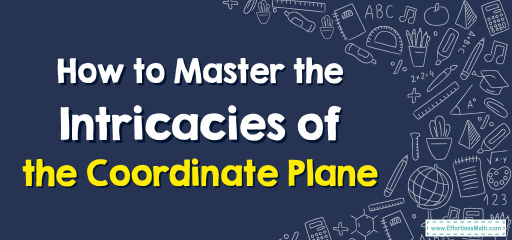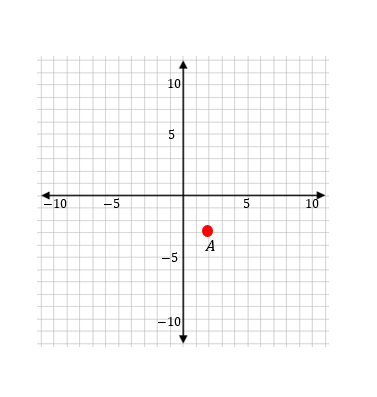How to Master the Intricacies of the Coordinate Plane
The coordinate plane, a fundamental concept in mathematics, serves as a two-dimensional system where each point is uniquely defined by a pair of numerical coordinates. From plotting simple points to tracing intricate curves, a coordinate plane is an indispensable tool, paving the way for advanced mathematical and scientific explorations.

Step-by-step Guide to Understand the Coordinate Plane
Here is a step-by-step guide to understand the Coordinate Plane:
Step 1: Diving into Origins – The Cartesian Theatre
Before delving into the crux of the matter, it’s enriching to appreciate the genesis of the coordinate plane. Descartes introduced this plane, painting a canvas where mathematics and geometry waltz harmoniously. It’s not just a grid; it’s the Cartesian plane, named after René Descartes.
Step 2: Grasping Basic Constructs – Axes and Quadrants
- Axes: Picture a cross in your mind. This is formed by two lines: the horizontal one, christened the \(x\)-axis, and the vertical counterpart, the \(y\)-axis.
- Quadrants: These axes, in their infinite wisdom, dissect the plane into four sections. Each of these is a quadrant. Starting from the top right and moving counterclockwise, we have the \(I, II, III\), and \(IV \)quadrants.
Step 3: Deciphering Coordinates – The Language of Points
A point on this plane is articulated as \((x, y)\). Here:
- \(x\): It whispers where the point lies along the horizontal axis.
- \(y\): It sings of the point’s position on the vertical axis.
Step 4: Plotting – An Art and Science
To craft a point on this canvas:
- Start at the origin.
- Go horizontally to the \(x\)-value.
- Go vertically to meet the \(y\)-value.
Step 5: The Dance of Symmetry – Reflections and Rotations
The plane is a mirror. A point’s reflection across the \(x\)-axis or \(y\)-axis transmutes its coordinates. For instance, if you reflect a point across the \(x\)-axis, its \(y\)-coordinate pirouettes to its negative form.
Step 6: Beyond the 2D – Welcome to 3D and the z-axis
Imagine extruding our plane like a pop-up book. This introduces a third dimension, represented by the \(z\)-axis. Now, points dance in \(3D\) space with coordinates \((x, y, z)\).
Step 7: The Curve’s Whisper – Graphing Functions
Our plane isn’t just for points; it’s for stories. Functions weave these tales. For example, \(y = x²\) depicts a parabolic ballet, with every \(x\) pirouetting to its squared value in \(y\).
Step 8: Distances and Midpoints – The Hidden Relationships
Delve into the Pythagorean theorem and you can unveil the distance between two star-crossed points. Similarly, with a sprinkle of arithmetic, the midpoint formula unveils their secret meeting place.
Step 9: Slants and Slopes – Rise Over Run
Slope, a measure of steepness, is calculated as the rise (change in \(y\)) divided by the run (change in \(x\)). It’s the rhythm of linear functions, narrating how one variable ascends or descends relative to the other.
Step 10: Wrapping it Up – The Infinite Stories
As you stand on the precipice of this vast plane, know that it holds infinite tales. From linear tales to sinusoidal epics, the coordinate plane is more than a grid—it’s the universe of mathematical narratives. Dive deep, explore, and add your own story to this ever-expanding tapestry.
Example:
Find the coordinates of point \(A\).

Solution:
Given a point on the coordinate plane, find its coordinates by determining its horizontal and vertical positions relative to the origin. The point \(A\) is located two units to the right and three units down from the origin have the coordinates \((2,-3)\).
Related to This Article
More math articles
- The Ultimate 7th Grade OAA Math Course (+FREE Worksheets)
- 5th Grade NYSE Math Practice Test Questions
- How to Solve Infinite Geometric Series? (+FREE Worksheet!)
- 5th Grade MAP Math FREE Sample Practice Questions
- ParaPro Math Formulas
- A Comprehensive Collection of FREE PSAT Math Practice Tests
- The Most Effective Methods for Learning Math Facts and Improving Number Sense
- The Ultimate ISEE Middle Level Math Formula Cheat Sheet
- Best Ergonomic Chairs for Online Teachers in 2024
- Why Project-Based Learning Works So Well for Students





















What people say about "How to Master the Intricacies of the Coordinate Plane - Effortless Math: We Help Students Learn to LOVE Mathematics"?
No one replied yet.